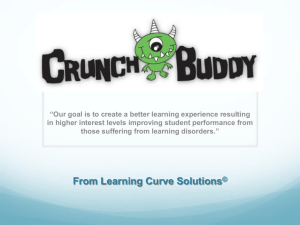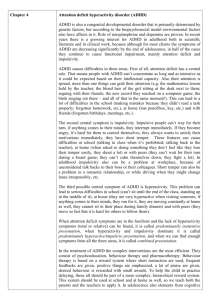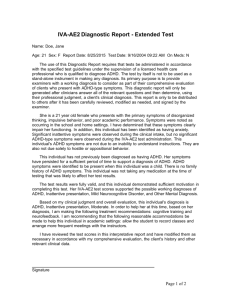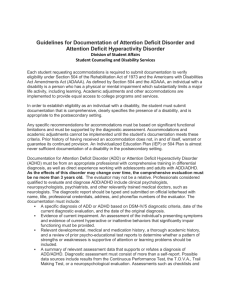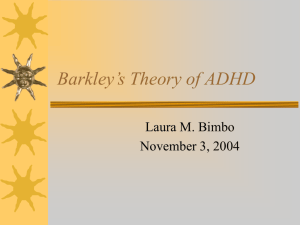File
advertisement
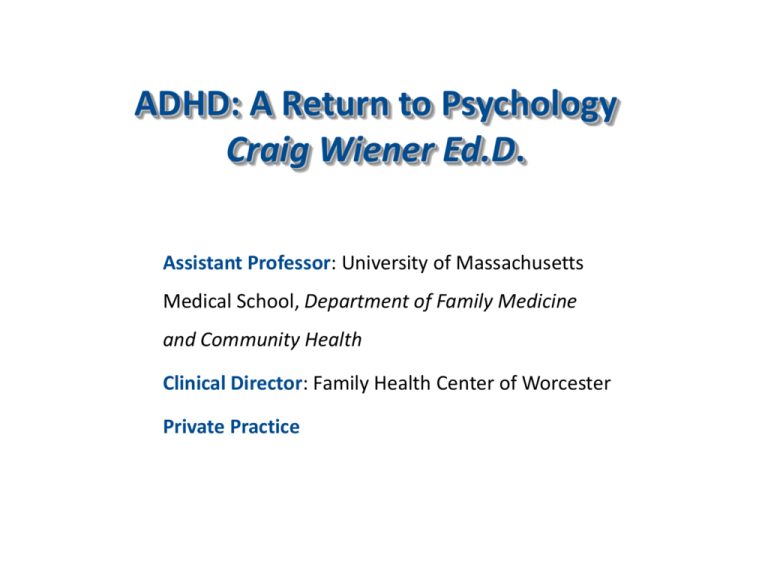
ADHD: A Return to Psychology Craig Wiener Ed.D. Assistant Professor: University of Massachusetts Medical School, Department of Family Medicine and Community Health Clinical Director: Family Health Center of Worcester Private Practice Current view • Delayed “inhibitory mechanism” • Biogenetic problem – Difficulty restraining short sighted responses • 9% of children Akinbami, L. J., X. M. Liu, P. N. Pastor, and C. A. Reuben. 2011 Traditionalists believe that people will be enticed by instant gratifications unless they can • Inhibit immediate reactions – engage “executive functioning” • and concentrate so that effective longerterm responses can be considered (Fuster, 1997; Barkley, 2006). Inferior biological/mental inhibitory mechanism Less able To stop, look, listen, and think before taking action (Douglas, 1972). They will not manage their futures effectively Traditional ADHD is based on three pillars (Pliszka, Mc-Cracken, and Maas, 1996). ADHD is thought to be a biological problem because It runs in families • Identical twins are almost always concordant • Molecular Biology is different – – 7-repeat allele (DRD4) Increase diagnosis 50% LaHose et al., 1996; Barkley, 2006 Brain structure and function are different – Brain structures • smaller and less differentiated – Diminished arousal and activation – Less availability of neurotransmitters • dopamine and norepinephrine Barkley, 2006; Brown, 2010 Medications work instantaneously • Since changing biology improves ADHD – the etiology of the behaviors must be biological In critique of the three pillars • In comparison to other medical problems – No biological markers or dysfunctions that reliably coincide with the diagnosis • Too many false positives and false negatives The genetic argument is not as strong as it appears – There are many diagnosed persons without the genetic variations – There are many non-diagnosed persons with the variations – Identified molecular biology • Only increases the chance of diagnosis from 9% to 13.5% – Hardly a reason to panic is your child has the identified genes (Chang, 1996: Shaw, 2007) It is anticipated that family members will show similar behaviors • Related people have similar bodies and environments – Their probabilities for learning are similar • Extreme with identical twins – A heightened confounding of genetics and learning Yes, biology changes the probability of what is learned – Height Basketball player – Physically Attractive Popular – Physically Awkward Low Social Status, Sports Avoidance Biological difficulties can increase the probability of learning ADHD For example – Developmental Delay • Coordination Disorder – Specific speech or learning problems – Health complications – Short attention span with objects – High activity levels – Demanding and intense responses – Negative infant temperament (Barkley, 2006) • Socializing a person to be concerned for others and independently responsible is difficult under these arduous conditions But not all children with these problems will learn ADHD behaviors And learning can also change biology – Dopamine levels can increase with positive experiences Schultz, Dayan, & Montague, 1997; Wickelgren, 1997 With musicians The planum temporale –becomes larger –more asymmetrical As a consequence of playing a musical instrument Gaser and Schlaug, 2003 This means that structural brain differences can occur as a result of learning •These differences show relationships between –patterns of living and biological developments •The consequence of the co-occurrence of biology and environment And Differences in brain response may relate to learning as well • MRI data shows – Brain blood flow varies in relation to observing someone with the same or different political affiliation – Patterns of brain activation and arousal can be a function of what the person is doing and what the person has learned Elias, 2004 Finally, Medicine might lessen ADHD Behavior • But this does not identify the cause of ADHD – Alcohol helps with sociability, but this does not tell us why the person was not social ADHD medications can be a potent and practical solution o Due to urgency and resources of participants o But they do not tell us about the genesis of ADHD Instead of thinking that ADHD is a biological deficit caused by genetics Ask yourself: – Why would a biological disability respond so remarkably to • Bribery • Personal interest • Instruction source (child initiated or expected by others) – How can a person outperform his disability? • Many parents ask, “Why can my child function so well when he is doing what he wants to do?” It is quite reasonable to assume • If the problem goes away when there is “personal interest” then the problem is psychological Do you see your child in the following cartoons? by Brian Nelson “Sun Spott Studios” Hyperactivity occurs when parents are on the phone But not if bedtime is extended while the parent talks Distractibility prevails when writing a “thank you” note But not when writing a Christmas list Blurting occurs when vying for attention or provoking But not when there could be incrimination Unpleasant appointments are often missed But it’s first in line for scheduled trips to the movies The daily planner •Is cast aside While plans on “My Space” are being made Personal belongings are –scattered about But battle scenes are meticulously arranged Chores are left undone But the house sparkles when “buttering up” the parent Contemplation is evident when making a purchase But not when shopping for a sibling Rather than disability ADHD behavior is reinforced in particular situations Your goal is to stop those reinforcements and instead foster your child’s self-reliance and cooperation Works cited Akinbami, L. J., X. M. Liu, P. N. Pastor, and C. A. Reuben. 2011. “Attention Deficit Hyperactivity Disorder among Children Aged 5–17 Years in the United States, 1998–2009.” NCHS Data Brief No. 70. August. http://www.cdc.gov/nchs/data/databriefs/db70.pdf. Barkley, R. A. Advances in ADHD: Theory, Diagnosis, and Management. J & K Seminars, 1861 Wickersham Lane, Lancaster, PA 17603, 2008. ______. Attention Deficit Hyperactive Disorder: A Handbook for Diagnosis and Treatment . New York: Guilford Press, 2006. ______. Attention Deficit Hyperactive Disorder: A Handbook for Diagnosis and Treatment.. New York: Guilford Press, 1998. ______. ADHD in Children, Adolescents and Adults: Diagnosis, Assessment, and Treatment. New England Educational Institute, Cape Cod Summer Symposia (Audio cassettes). New England Educational Institute, Pittsfield, MA, 2000. Brown, T. Recognizing and treating adult ADHD. In Shnitzer, N. New England Psychologist. Vol. 18, no. 5, p. 2, June 10, 2010. Chang, F., Kidd, J., Livak, K., Pakstis, A., Kidd, K., “The World-Wide Distribution of Allele Frequencies at the Human Dopamine D4 Receptor Locus”, Human Genetics, 98, (1996): 91-101. Douglas, V. I. “Stop, Look, and Listen: The Problem of Sustained Attention and Impulse Control in Hyperactive and Normal Children.” Canadian Journal of Behavioural Science 4 (1972): 259–82. Elias, P. “Brain Scans a Political Tool?” Telegram & Gazette. October 29, 2004, A13. Fuster, M. M. The Prefrontal Cortex (3d ed.) New York: Raven, 1997. Gaser, C., and G. Schlaug. “Brain Structures Differ between Musicians and Non-Musicians.” The Journal of Neuroscience 23, no. 27 (2003): 9240–45. A. O., & Bedi, R.P. The alliance. In J. C. Norcross (Ed.), Psychotherapy relationships that work: Therapist contributions and responsiveness to patients (p. 37-69). New York: Oxford University, 2002. LaHoste, G. J., J. M. Swanson, S. B. Wigal, C. Glabe, T. Wigal, N. King, et al. “Dopamine D4 Receptor Gene Polymorphism is Associated with Attention Deficit Hyperactivity Disorder.” Molecular Psychiatry 1 (1996): 121–24. Pliszka, L. R., J. T. McCracken, and J. W. Maas. “Catecholamines in Attention Deficit Hyperactivity Disorder: Current Perspectives.” Journal of the American Academy of Child and Adolescent Psychiatry 35 (1996): 264–72. Schultz, W., P. Dayan, and P. R. Montague. “A Neural Substrate of Prediction and Reward.” Science 275 (1997): 1593. Shaw, P. et. al. Polymorphisms of the Dopamine D4 Receptor, Clinical Outcome, and Cortical Structure in Attention-Deficit/Hyperactivity Disorder, Arch Gen Psychiatry. 2007;64:921-931. Wickelgren, I. “Getting the Brain’s Attention.” Science 278 (1997): 35–37.
